
In modern physics, antimatter is defined as matter composed of the antiparticles of the corresponding particles in "ordinary" matter, and can be thought of as matter with reversed charge, parity, and time, known as CPT reversal. Antimatter occurs in natural processes like cosmic ray collisions and some types of radioactive decay, but only a tiny fraction of these have successfully been bound together in experiments to form antiatoms. Minuscule numbers of antiparticles can be generated at particle accelerators; however, total artificial production has been only a few nanograms. No macroscopic amount of antimatter has ever been assembled due to the extreme cost and difficulty of production and handling. Nonetheless, antimatter is an essential component of widely available applications related to beta decay, such as positron emission tomography, radiation therapy, and industrial imaging.

Cloud albedo is a measure of the albedo or reflectivity of a cloud. Clouds regulate the amount of solar radiation absorbed by a planet and its solar surface irradiance. Generally, increased cloud cover correlates to a higher albedo and a lower absorption of solar energy. Cloud albedo strongly influences the Earth's energy budget, accounting for approximately half of Earth's albedo. Cloud albedo is influenced by the conditions of cloud formation and variations in cloud albedo depend on the total mass of water, the size and shape of the droplets or particles and their distribution in space. Thick clouds reflect a large amount of incoming solar radiation, translating to a high albedo. Thin clouds tend to transmit more solar radiation and, therefore, have a low albedo. Changes in cloud albedo caused by variations in cloud properties have a significant effect on global climate, having the ability to spiral into feedback loops.

Cosmic rays or astroparticles are high-energy particles or clusters of particles that move through space at nearly the speed of light. They originate from the Sun, from outside of the Solar System in our own galaxy, and from distant galaxies. Upon impact with Earth's atmosphere, cosmic rays produce showers of secondary particles, some of which reach the surface, although the bulk are deflected off into space by the magnetosphere or the heliosphere.

The antiproton,
p
, is the antiparticle of the proton. Antiprotons are stable, but they are typically short-lived, since any collision with a proton will cause both particles to be annihilated in a burst of energy.
Nephology is the study of clouds and cloud formation. British meteorologist Luke Howard was a major researcher within this field, establishing a cloud classification system. While this branch of meteorology still exists today, the term nephology, or nephologist is rarely used. The term came into use at the end of the nineteenth century, and fell out of common use by the middle of the twentieth. Recently, interest in nephology has increased as some meteorologists have begun to focus on the relationship between clouds and global warming, which is a source of uncertainty regarding "estimates and interpretations of the Earth’s changing energy budget."
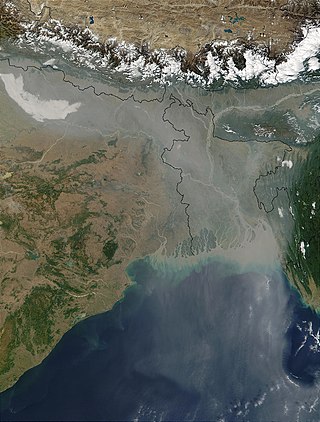
Cloud condensation nuclei (CCNs), also known as cloud seeds, are small particles typically 0.2 μm, or one hundredth the size of a cloud droplet. CCNs are a unique subset of aerosols in the atmosphere on which water vapour condenses. This can affect the radiative properties of clouds and the overall atmosphere. Water vapour requires a non-gaseous surface to make the transition to a liquid; this process is called condensation.
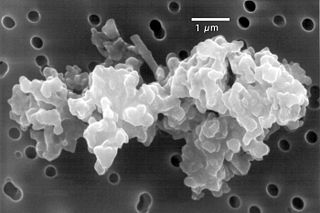
Cosmic dust – also called extraterrestrial dust, space dust, or star dust – is dust that occurs in outer space or has fallen onto Earth. Most cosmic dust particles measure between a few molecules and 0.1 mm (100 μm), such as micrometeoroids and meteoroids. Cosmic dust can be further distinguished by its astronomical location: intergalactic dust, interstellar dust, interplanetary dust, and circumplanetary dust. There are several methods to obtain space dust measurement.

PAMELA was a cosmic ray research module attached to an Earth orbiting satellite. PAMELA was launched on 15 June 2006 and was the first satellite-based experiment dedicated to the detection of cosmic rays, with a particular focus on their antimatter component, in the form of positrons and antiprotons. Other objectives included long-term monitoring of the solar modulation of cosmic rays, measurements of energetic particles from the Sun, high-energy particles in Earth's magnetosphere and Jovian electrons. It was also hoped that it may detect evidence of dark matter annihilation. PAMELA operations were terminated in 2016, as were the operations of the host-satellite Resurs-DK1. The experiment was a recognized CERN experiment (RE2B).
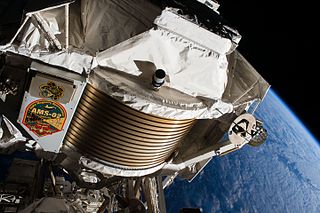
The Alpha Magnetic Spectrometer (AMS-02) is a particle physics experiment module that is mounted on the International Space Station (ISS). The experiment is a recognized CERN experiment (RE1). The module is a detector that measures antimatter in cosmic rays; this information is needed to understand the formation of the universe and search for evidence of dark matter.
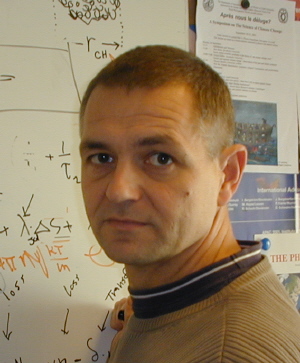
Henrik Svensmark is a physicist and professor in the Division of Solar System Physics at the Danish National Space Institute in Copenhagen. He is known for his work on the hypothesis that fewer cosmic rays are an indirect cause of global warming via cloud formation.
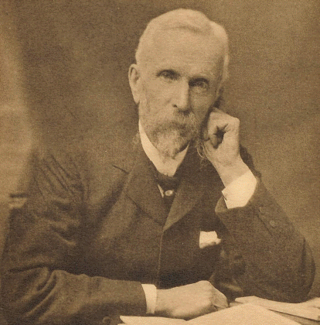
John Aitken, FRS, FRSE LLD was a Scottish meteorologist, physicist and marine engineer. He was one of the founders of cloud physics and aerosol science, who built the first apparatus to measure the number of dust and fog particles in the atmosphere, a koniscope.
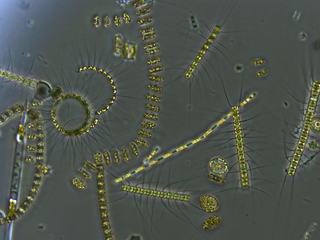
The CLAW hypothesis proposes a negative feedback loop that operates between ocean ecosystems and the Earth's climate. The hypothesis specifically proposes that particular phytoplankton that produce dimethyl sulfide are responsive to variations in climate forcing, and that these responses act to stabilise the temperature of the Earth's atmosphere. The CLAW hypothesis was originally proposed by Robert Jay Charlson, James Lovelock, Meinrat Andreae and Stephen G. Warren, and takes its acronym from the first letter of their surnames.

Cosmics Leaving Outdoor Droplets (CLOUD) is an experiment being run at CERN by a group of researchers led by Jasper Kirkby to investigate the microphysics between galactic cosmic rays (GCRs) and aerosols under controlled conditions. This is a fixed-target experiment that began operation in November 2009, though it was originally proposed in 2000.
A strangelet is a hypothetical particle consisting of a bound state of roughly equal numbers of up, down, and strange quarks. An equivalent description is that a strangelet is a small fragment of strange matter, small enough to be considered a particle. The size of an object composed of strange matter could, theoretically, range from a few femtometers across to arbitrarily large. Once the size becomes macroscopic, such an object is usually called a strange star. The term "strangelet" originates with Edward Farhi and Robert Jaffe in 1984. It has been theorized that strangelets can convert matter to strange matter on contact. Strangelets have also been suggested as a dark matter candidate.

Tihomir Novakov, Ph.D known also as Tica Novakov was a Serbian-born American physicist. As a scientist, Novakov is known for his black carbon, air quality, and climate change research. James Hansen dubbed him "the godfather of black carbon".
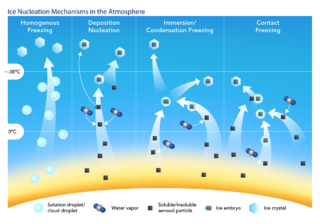
An ice nucleus, also known as an ice nucleating particle (INP), is a particle which acts as the nucleus for the formation of an ice crystal in the atmosphere.

Ashot Chilingarian is an Armenian physicist known for his contributions to the fields of high-energy astrophysics, space weather, and high-energy atmospheric physics. He is the head of the Cosmic Ray Division (CRD) and the director of the Alikhanyan Physics Institute in Armenia.

Patterns of solar irradiance and solar variation have been a main driver of climate change over the millions to billions of years of the geologic time scale.

Cirrus cloud thinning (CCT) is a recent form of climate engineering. Cirrus clouds are high cold ice that, like other clouds, both reflect sunlight and absorb warming infrared radiation. However, they differ from other types of clouds in that, on average, infrared absorption outweighs sunlight reflection, resulting in a net warming effect on the climate. Therefore, thinning or removing these clouds would reduce their heat trapping capacity, resulting in a cooling effect on Earth's climate. This could be a potential tool to reduce anthropogenic global warming. Cirrus cloud thinning is an alternative category of climate engineering, in addition to solar radiation management and greenhouse gas removal.

The North Atlantic Aerosols and Marine Ecosystems Study (NAAMES) was a five-year scientific research program that investigated aspects of phytoplankton dynamics in ocean ecosystems, and how such dynamics influence atmospheric aerosols, clouds, and climate. The study focused on the sub-arctic region of the North Atlantic Ocean, which is the site of one of Earth's largest recurring phytoplankton blooms. The long history of research in this location, as well as relative ease of accessibility, made the North Atlantic an ideal location to test prevailing scientific hypotheses in an effort to better understand the role of phytoplankton aerosol emissions on Earth's energy budget.


















